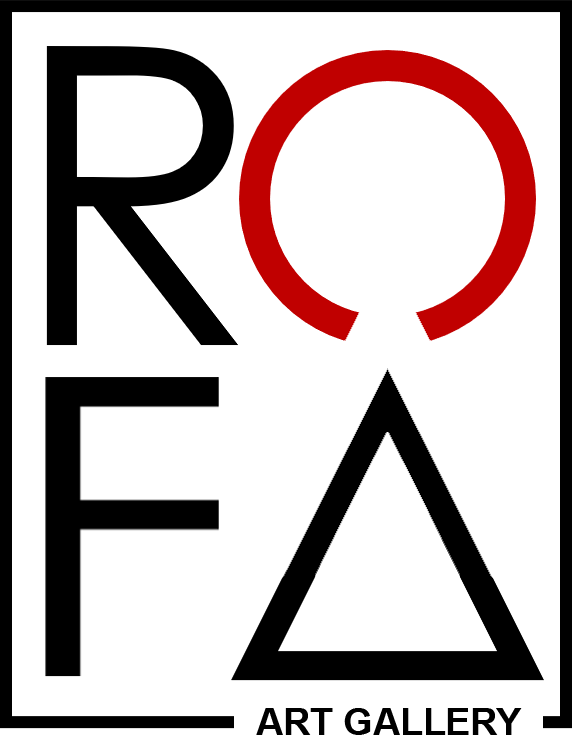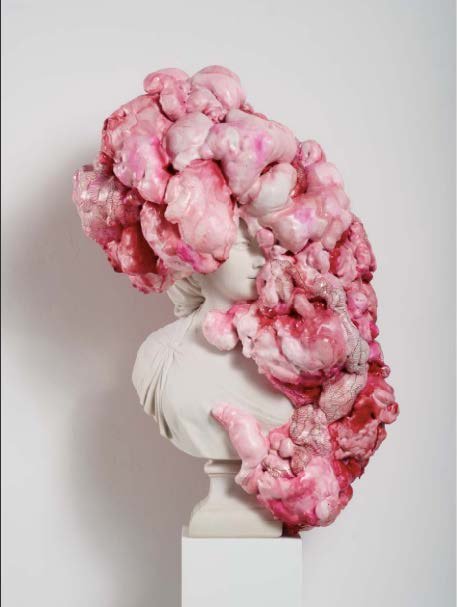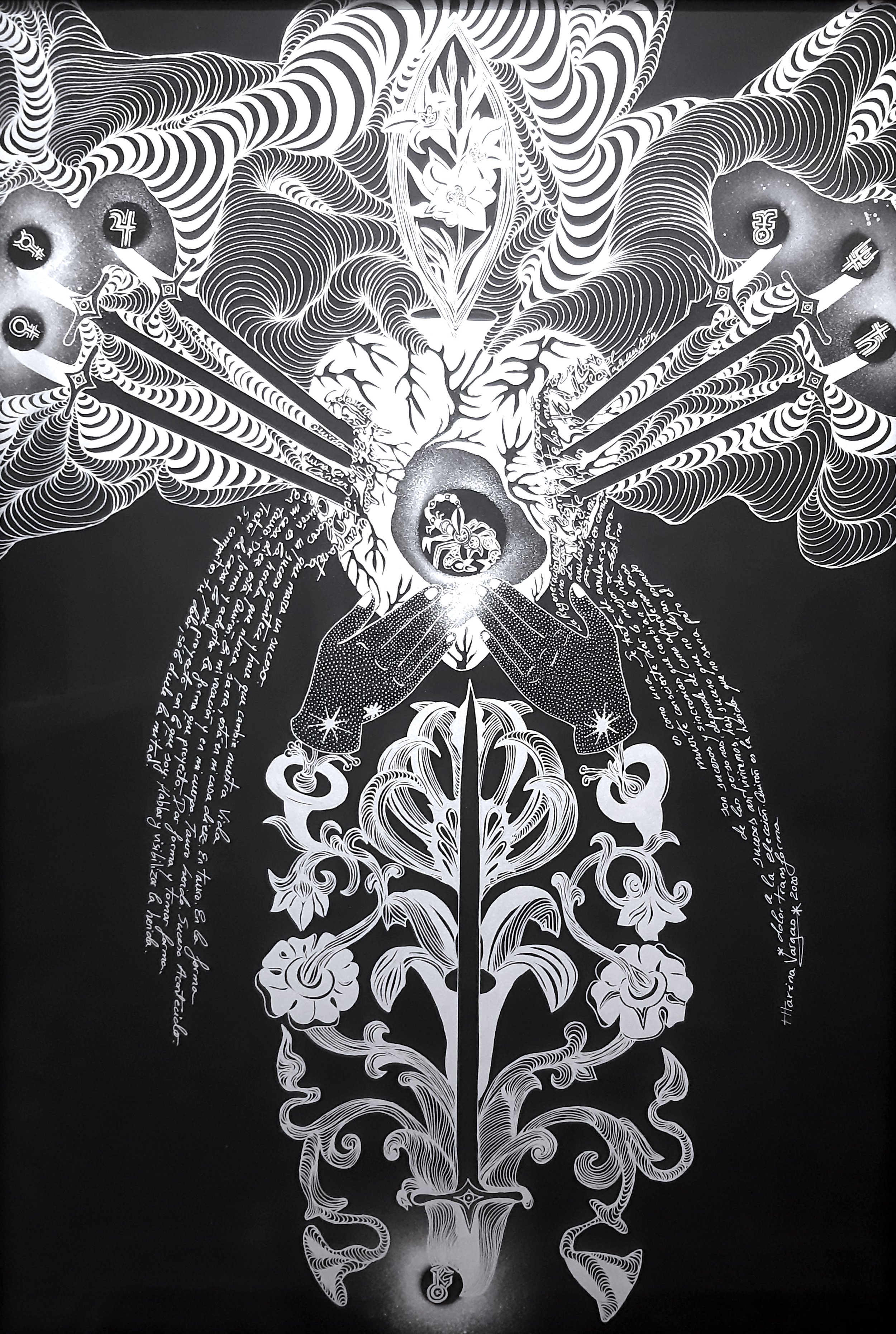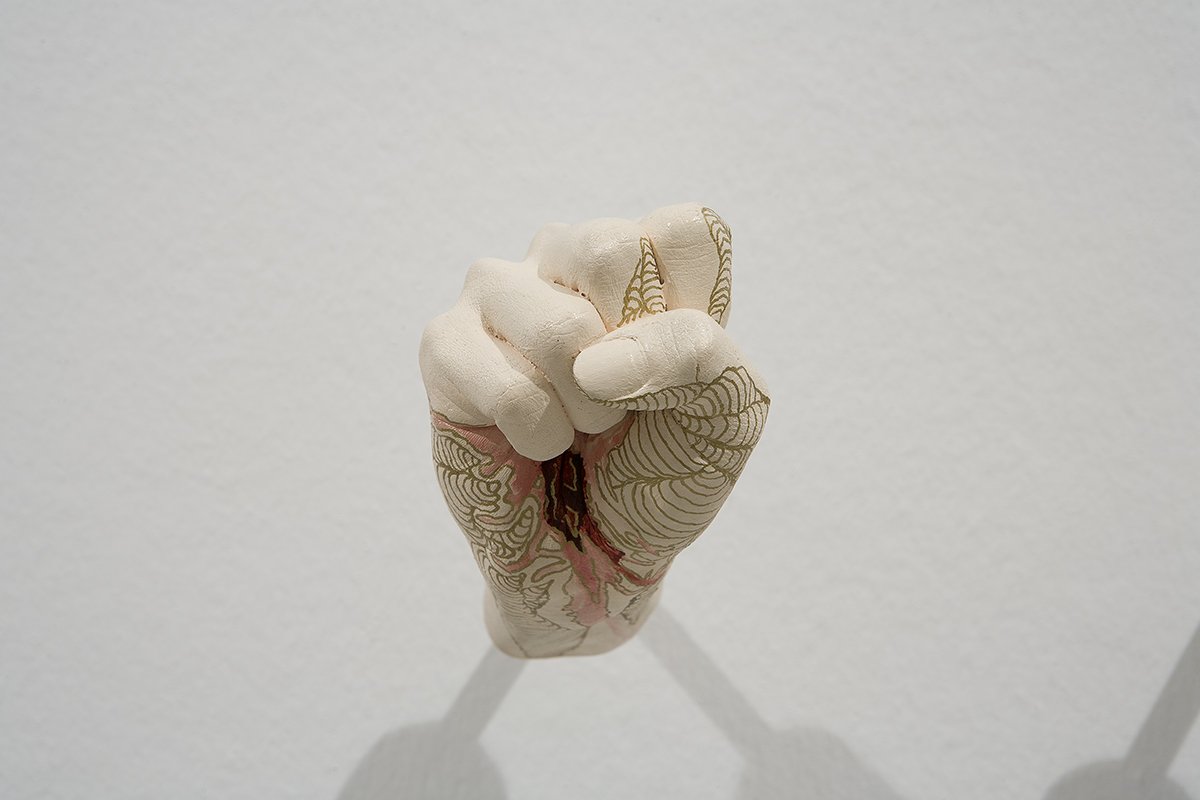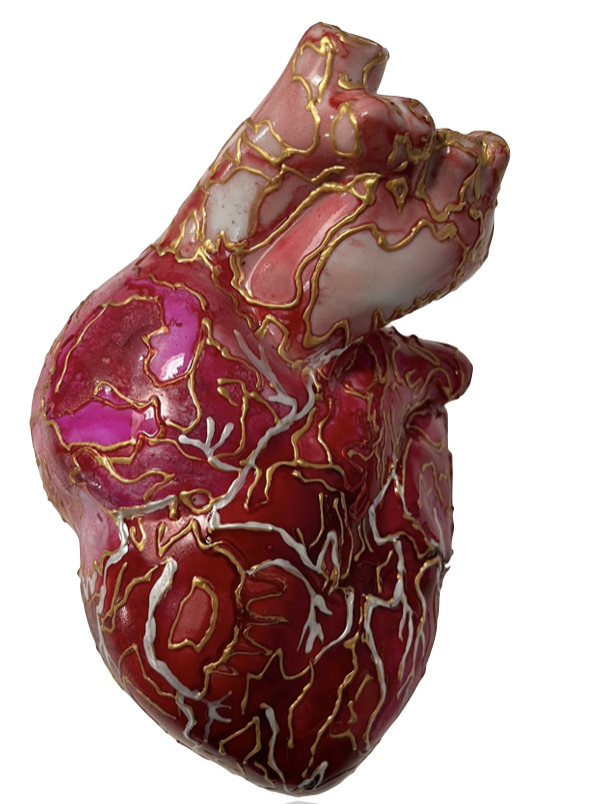Marina Vargas
Marina Vargas earned her BFA and MFA in Visual Language from the University of Granada and is currently a member of la Logía "Las Roldanas," which works to address the revaluation of labor of women artists in Spain and Latin America. Vargas works with an array of media to create an astounding oeuvre that bewitches audiences worldwide. From painting to video art, drawing to sculpture, photography to installation art, Vargas’ work begs spectators to interrogate origin stories, the sacred, and the secular. She proclaims: “I try to walk the tightrope, bringing what’s in the sky down to earth and lifting what’s on the earth up to the sky. That’s the motor that leads me to do what I do: mediate between those two planes knowing that I possess no certainty, and working on the questions I find on the way”.
SPEAK UP. Is a phrase spelled according to the universal alphabet of sign language. This proposal highlights the metalanguage and matter from a feminist approach. The universal alphabet of sign language is an alphabet that was created for the Olympics to have international communication in sign language.
It is what is called "International Sign System" (ISS) is a variant of sign language used in different contexts, particularly in international meetings such as the congress of the World Federation of the Deaf, the Deaflympics and informally, socializing on trips all over the world.
It is ironic and feminist since its very existence refers to the need to break the silence and listen to the word.
Silence is a form of control and domination used by the patriarchal system so that women do not tell their stories or generate public stories that claim the abuse they suffer and thus maintain power relations.
There are many ways of speaking, within them we highlight art and positioning and empowerment through it.
The Lines of Destiny. “The Lines of Destiny” is a project that takes as its object of study the Marseille tarot deck and what is hidden behind each image; archetypes, symbols and numerology, to build my own system, with the aim of creating my own deck.
Many artists have worked with the tarot, from the psychoanalyst Carl Jung, who made an in-depth study of the archetypes of the deck, to the occultist and mystic Aleister Crowley who, together with the painter Lady Frieda Harris, created their own cards. Dalí, André, Bretón, Remedios Varo, Alejandro Jodorowsky, Leonora Carrington or Niki de Saint Phalle and her tarot garden are other artists who have worked on this subject.
The tarot is an optical language, it is a silent book that teaches you to sharpen your eyes and let yourself be guided by the images. It is necessary to look with perspective, because all the details form a symbolic reality full of signs. I am very interested in studying this oracle regardless of the predictive power that its popularity gives it. The power of connecting with the person who contemplates the letters, is for me similar to the power of connection of the spectator who contemplates a work. I create my own deck based on the runs and queries that I make over time. In this way, I also rely on chance, its combination, and the different readings that an image can have.
"The Lines of Destiny" is what I call a "project of life". I do not decide the time of execution and completion of the project, since it depends on the number of queries and the number of letters of each pulled. It is possible that this project has no end. Something that I have decided very consciously because I find it very interesting that it is chance that decides whether it will end or not. Importance is given to the ritual as the very process of the work.
Nor Animal Nor Angel. Questions the Greco-Roman canons that we have established as dogmatic truths and asks us about the atavistic symbols that survive in time thanks to their transmutation into allegories of power. The castings in resin and marble powder represent a review of the discipline in an ironic, feminist and deconstructive key, through which the artist dismantles the hegemonic discourse of the canon and of the cultural stories that tradition, economic power and politics have perpetuated throughout history.
The starting point of such a demystifying stake are the canonical references that have illustrated both the History of Art and that of aesthetic and cultural ideas, and that throughout the centuries have perpetuated memorable images of perfection and beauty to imitate, being repeated in The West as an inexhaustible source of reference from the Academy. Exporting them even to the rest of the world as a universal iconography under which a single, dogmatic and imposing idea of the world was included. But wrapped in the pink foam hardened with polyurea, these same figures of seriousness and ideological rectitude suddenly become ambiguous, are hidden, or fall from the pedestal, suspending the intention of their former moral and aesthetic clarity. The action that affects them does not wear them out, like the erosion of the passage of time, but on the contrary, it envelops them, covers them up and ends up suffocating them: it is an attack.
Faced with the control of ideas by way of proportion and perfection, we have here the formless, the grotesque, the monstrous; and a good number of "negative" categories of aesthetics burst in here to end up knocking down these idols, cold stars of snowy beauty, of marvelous clarity, which remind us in their agonizing convulsion that they belong to an order and a time to which we no longer belong.
Action Items, Protection Items - Para que no me pongas un pero. Objects of action-Objects of protection records actions and popular rituals, conceiving the sculpture as an amulet that records actions around superstitions that are maintained over time by way of tradition. In this case, sticking a pair of scissors into an apple( pero) is typical of Granada to "cut the buts“. In Granada we also call apples "buts" and scissors are stuck in them to drive away doubts, drive away negativity and protect us from malicious glances. This action for the artist becomes a symbolically feminist action that breaks and fractures the symbolic charge that an apple contains in occident.
BIO.
Marina Vargas (Granada, 1980)
Lives and works in Madrid, Spain. Graduated in Fine Arts from the University of Granada in 2003, later at this same university she took doctorate courses and a master's degree in Production and Research in Artistic Languages in 2011. Since 2001, before her degree, she began his professional career exhibiting experimental works in different spaces. It has recently been appointed curator of the CNIO Art. An initiative of the National Cancer Research Center of Spain that establishes contact between leading international scientists and artists to explore the common ground between scientific research and artistic creation. This work is complemented by being the president of the Intra-Venus association. Association of creators for the visibility and support of women in cancer processes.
Her work, which includes formats such as photography, sculpture, drawing, or painting, revolve around concepts such as cultural heritage and its meanings throughout history. In his works there are constant dialogues around sexuality, femininity, violence, love and desire; a work full of drama, brutality and combined beauty. Reigning the revisionist symbolism of contemporary identities, creating a new model of hybrid and monstrous beauty that has completely forgotten the silence of the classical canon.
Among her most recent individual exhibitions, it is worth mentioning: "Contra el Canon" 2022, curated by Marta Mantecón in the mythical Robayera room in Santander, Spain. The Body of Love curated by Óscar Alonso Molina at Llamazares Gallery in Gijón, Spain. Rito e Realtá 2019. Civiero Art Gellery. Palace of the Park, Diano. Marine. Italy. The aesthetics of Vertigo 2018, at Costantini Art Gallery. Milan. Italy. The Inverted Piety or The Dead Mother 2017 at Ge Gallery, Monteerrey, Mexico. The Lines of Destiny 2016; curated by Óscar Alonso Molina at the ABC Museum of Drawing and Illustration in Madrid. Neither Animal nor Animal nor Angel 2015-2016 at the Contemporary Art Center of Malaga or Nobody is Immune, curated by Omar Pascual Castillo at the Atlantic Center for Contemporary Art (CAAM), in Las Palmas de Gran Canaria, in Spain. He has received numerous awards in 2020 he receives the Plastic Arts award in the XIII edition of the "La Rural" Plastic Arts Contest, organized by the Caja Rural de Jaén Foundation. In 2021 she receives the award for the best artist from the White, Black and Magenta association. Association of women artists that works from the visual arts on the concept of equality. And in 2022 she receives the Nebrija Crea Visual Arts Award, being chosen by the students of the Nebrija University of Madrid.
She has participated in numerous fairs such as Arco in Spain, Maco in Mexico, Volta New York, Contemporary Istanbul, MiArt in Milan or Artfiere in Bologna, among others. Her work is part of numerous public collections, including: ARTIUM Centro - Museo Vasco de Arte Contemporáneo, Vitoria – Gasteiz; CAAC - Centro Andaluz de Arte Contemporáneo, Sevilla. Colección Iniciarte, Junta de Andalucía; CAAM - Centro Atlántico de Arte Moderno, Las Palmas de Gran Canarias; CAC Málaga - Centro de Arte Contemporáneo de Málaga; Caja de Extremadura; Centre d'Art Contemporain Essaouira, Ifitry, Marruecos; Fundación Antonio Gala, Córdoba; Fundación Focus Abengoa, Sevilla; IAJ - Instituto Andaluz de la Juventud, Diputación de Málaga; Museo - Fundación Gregorio Prieto, Ciudad Real; Iniciarte. Junta de Andalucia.; Instituto Andaluz de la Juventud.; Colección DKV; Fundación Benetton. Italia.; Colección Pilar Citoler.
